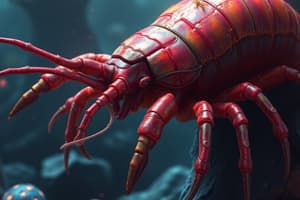Podcast
Questions and Answers
What is the distinguishing characteristic of Hemiptera's mouthparts?
What is the distinguishing characteristic of Hemiptera's mouthparts?
Piercing and sucking mouthparts modified into a rostrum (beak)
What is the unique feature of Isoptera's wings?
What is the unique feature of Isoptera's wings?
Membranous fore and hind wings
Describe the mouthparts of Dictyoptera.
Describe the mouthparts of Dictyoptera.
Strong biting mouth parts
What is the defining characteristic of Anopleura's body shape?
What is the defining characteristic of Anopleura's body shape?
How do Siphonaptera's hind legs differ from other insects?
How do Siphonaptera's hind legs differ from other insects?
Flashcards are hidden until you start studying
Study Notes
Phylum Arthropoda
- Body covered by chitinous exoskeleton
- Metameric segmented body with each segment bearing a pair of jointed appendages for locomotion, feeding, or sensory purposes
- Bilaterally symmetrical body
- Periodic shedding of cuticle (moulting/ecdysis) for growth
Class Crustacea (Crustaceans)
- Mainly aquatic, with some found in terrestrial habitats
- Two body divisions: cephalothorax (fused head and thorax) covered by carapace, and abdomen
- Head bears two pairs of antennae, one usually larger than the other
- Pair of compound eyes raised on stalks
- Five pairs of walking legs on the cephalothorax
- Gaseous exchange mainly by gills
- Three pairs of mouthparts: one pair of mandible (jaws) for biting, cutting, or chewing, and two pairs of maxillae for holding or transporting food
- Examples include crabs, lobsters, Palaemon (giant prawn), Astacus (crayfish), barnacles, shrimps, water fleas, and copepods
Class Chilopoda (Centipedes)
- Mainly terrestrial, living in moist places, under stones, leaves, and in soil
- Two body divisions: a head and a slender trunk
- Head bears a pair of antennae and a pair of poisonous claws (fangs) at the first body segment
- Gaseous exchange by trachea
- Many tiny holes along the body (spiracles) for air entry
Class Bivalvia (Bivalves)
- Mostly aquatic, found in rocky shores, lagoons, and estuaries
- Shell composed of two valves (bivalves) held together by a hinge, enclosing the body
- Filter feeders, feeding on microscopic organisms from water
- Head reduced in size, with no tentacles
- Bilaterally symmetrical
- Examples include mussels, clams, and oysters
Class Cephalopoda (Cephalopods)
- Well-developed head and eyes
- Ring of tentacles with suckers on the head for seizing prey
- Radula and horny beak for feeding
- Shell may be external or internal
- Bilaterally symmetrical
- Examples include squid and octopus
Phylum Echinodermata (Echinoderms)
- Mainly marine organisms, non-chordates with endoskeleton containing calcareous ossicles
- Spiny body with five-way radial symmetry in adults
- Head is absent
- Tube feet (suction cups) for locomotion and holding onto surfaces or prey shells
- Triploblastic, coelomate, and belong to the organ system of organization
- Examples include starfish and sea urchins
- Divided into two main classes: Class Stelleroidea (starfish, brittle stars) and Class Echinoidea (sea urchins)
Studying That Suits You
Use AI to generate personalized quizzes and flashcards to suit your learning preferences.




